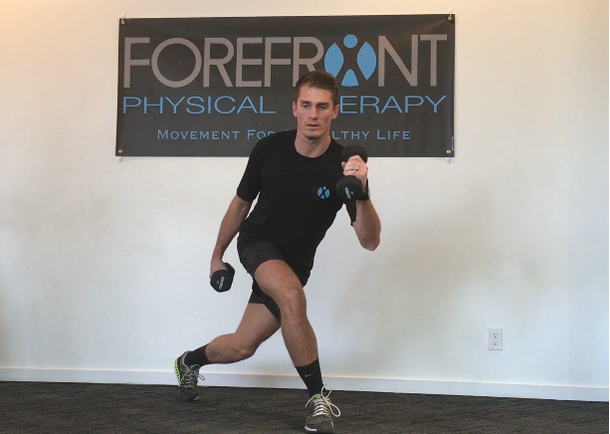|
12/18/2017 Six Ways to Improve Your Running Performance This Offseason - Part VI: Running Related Strength TrainingRead NowRunning Specific Strength Training Is Essential To Any Runner’s Weekly TrainingYou may be intimately familiar with every tree root and concrete bump as you make your way around the 3-mile Green Lake loop, but are you familiar with 3-dimensional split squats? Or a single leg Romanian Deadlift? How about multi-angle pistol squats? Running is incredibly effective at training cardiovascular endurance, however, strength training is often neglected by runners and should be a key component to their fitness. Why Is Strength Training Essential For Runners? When compared to walking, running increases ground reaction forces around three times one’s body weight per step. This means that someone weighing 120 pounds may have up to 360 pounds of force bearing down on a single leg while running. Multiply that by the thousands of steps taken per run and it is now easy to realize that the biomechanical load going through the body is huge! Muscle and connective tissue need to be adequately strong to successfully bear such intense repetitive forces. Strength training places greater than normal stress through these tissues which results in physiological adaptation and increased strength - exactly what runners need to safely tolerate the forces inherent to running. What Kind of Strength Training is Running Specific? A program to load the body in running specific positions will help increase speed, endurance, muscle, and connective tissue strength. Plus, it decreases the likelihood of running related injury! A running strength training program should focus on the specific needs of runners including, but not limited to, the notoriously weak posterior chain (glutes and hamstrings). An effective program should also consist of compound, multi-joint movements (eg. squats and deadlifts) and not the knee extension machine at the gym! Since running involves alternating single leg support, strength training should include single leg drills. Additionally, strength moves must be done 3-dimensionally. Will Strength Training Increase My Body Weight? One of the most common misconceptions is that runners who perform strength training will end up with too much muscle hypertrophy, or increased muscle mass, and thus, increased body weight. At the physiological level, running is a catabolic form of exercise (muscle breaks down), whereas weightlifting is typically anabolic (muscle is created). A proper balance of catabolic (running) and anabolic (strength training) exercise will lead to the creation of lean, healthy muscle mass. This physiological opposition will make strength training unlikely to increase body weight. Weight gain may occur if caloric intake is increased drastically or the running regimen is reduced, thereby creating a situation in which anabolic exercise is greater than catabolic. Does CrossFit Count As Strength Training for Runners? CrossFit could be a good strength training supplement, but there are caveats. Although some CrossFit movements are helpful for runners, it does not effectively address the specific needs of runners. Plus, many movements require a lot of practice in order to be performed safely. Some lifts may be too advanced for novices and often lead to injury due to compensatory patterns. I recommend CrossFit only for runners who have already been participating in classes and feel comfortable with all movements. And for those who are comfortable with CrossFit workouts, I still recommend they integrate more functional, running specific exercise. For new runners or those just beginning to explore a strength training regimen, I recommend they initially refrain from CrossFit, and instead perfect less advanced movements like squatting, lunging, and deadlifting. The risk for injury in CrossFit without proper mobility, stability, and technique training first is not worth the potential gains in strength. Additionally, 3-dimensional, running specific exercise must be incorporated in a runners strength program regardless of CrossFit workouts. How Often Should I Strength Train? A strength program should be utilized once per week, at the minimum, and up to three times per week at the maximum. To maximize the benefits of strength training, I recommend strength training on “easy run days” to help prevent injury and compensatory movements. Do I Need a Gym Membership to Do Strength Training? Definitely not! Strength training can be completed with little to no equipment. However, adding resistance (barbells, dumbbells, kettlebells, cable pulleys) will make it easier to increase strength gains. What Lifts Should I Be Doing? As mentioned above, running specific strength training should mimic the natural gait cycle. Movements like single leg deadlifts, single leg squats, and lunges can be tailored for running specific training. Endurance athletes should be able to do 3-5 sets of 16-24 repetitions of each movement/lift they are completing. Still unsure about what lifts to do and how to program strength training for runners? Forefront offers a personalized, step-by-step guide for strength training. After going through our functional mobility and strength examination, we will create a program specific to your needs and goals. Contact bwhitley@forefrontpllc.com for more information. 3-Dimensional Lunge Matrix + Speed Skater Single Leg Squats with "Running Arms"3-Dimensional Single Leg Squats with "Running Arms" |
Details
Forefront AuthorsWe love writing about injury prevention and functional exercise. We want everyone to share in our motto: movement for a healthy life! Archives
June 2020
Categories
All
|
Signup To Be At The Forefront Of Injury Recovery & Fitness Tips!
Get out of pain and move better!
Scheduling & Inquiries
hello@forefrontpllc.com
Call or Text: (206) 279-2870
Fax: (206) 279-2872
Mailing Address
Forefront Physical Therapy ● 2212 Queen Anne Ave N #333 ● Seattle, WA 98109
Scheduling & Inquiries
hello@forefrontpllc.com
Call or Text: (206) 279-2870
Fax: (206) 279-2872
Mailing Address
Forefront Physical Therapy ● 2212 Queen Anne Ave N #333 ● Seattle, WA 98109
Billing Questions
cclemmons@omnimbs.com
cclemmons@omnimbs.com
Movement For A Healthy Life
Employment Opportunities
Forefront Physical Therapy operates on an entirely paperless system
Frequently Asked Questions
Employment Opportunities
Forefront Physical Therapy operates on an entirely paperless system
Frequently Asked Questions
© 2023 Forefront Physical Therapy, PLLC


 RSS Feed
RSS Feed
